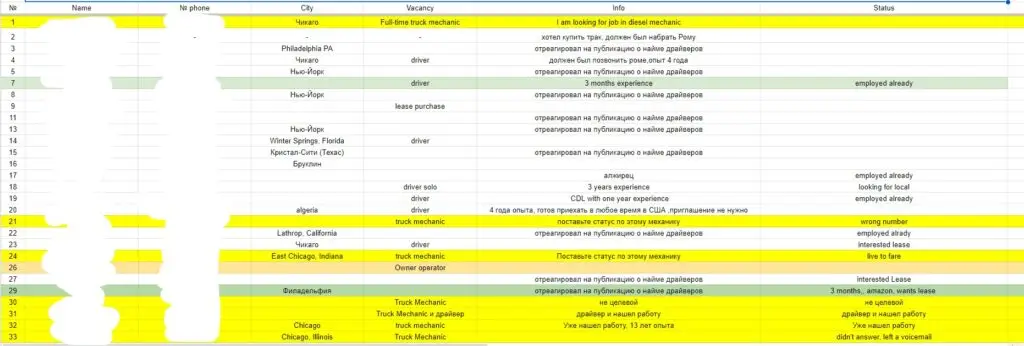
Evaluating the effectiveness of working with transport companies (CDL and non-CDL) consists of two parts.
The first one is the effectiveness of the lead generation part itself. That is, the calculation and analysis of the conversion of organic traffic and advertising into leads (applications).
The second is the conversion of generated leads into closed driver vacancies.
Collecting all the necessary data for performance analysis is not a problem when you have a properly configured CRM.
However, during the 3.5 years of working with the promotion of the driver hiring niche, we have not had a single client company that had a CRM.
Therefore, I will tell you how our agency solves the problem of evaluating the effectiveness of projects in such conditions.
The first part (analyzing the conversion of organic traffic and advertising into leads) is usually not difficult. Here, all the necessary data is taken directly from the advertising accounts.
The main indicators are conversion rate (CR) and cost per lead (CPL).
At the start of the project, their values are hypothetically assumed, and then a KPI is formed as a micro-conversion from the statistics obtained.

The second part (conversion of leads into closed vacancies) can be more complicated, as lead processing and closing of vacancies takes place on the Client’s side.
That is, communication with potential drivers is already conducted by employees of the Client’s company. This means that they also have all the data on the quality of the leads.
At this stage, properly built analytics is very important, and the data for it will be transferred to the agency on a regular and timely basis. We have already written about this.
So, what system do we offer for analysis?
All received leads are entered into a Google spreadsheet. It must include:
- date of receipt of the lead;
- the channel from which the lead was received;
- lead data (name, surname, location, contact details);
- details of work experience, if requested at the stage of lead collection.
Next, the date of the first feedback from the company’s employee must be indicated. This makes it clear how quickly the lead was contacted after receiving the application.
And then, of course, the result.
Obviously, one contact with a candidate is not always enough to fully qualify a lead (as relevant or not).
In such cases, the table horizontally records each contact with a particular candidate (correspondence, call, visit to the office), indicating the date of contact and the result.
For irrelevant leads, it is imperative to indicate the reason for the refusal to work, regardless of whether the driver refused or the company refused.

As the data in such a table accumulates, in addition to the conversion rate of leads to jobs, we can get several other very useful parameters.
1. Average time to hire a driver.
This means how long it takes from the moment an application (lead) is received until the driver is hired. This is important not only for calculating the effectiveness of promotion, but also for optimizing processes within the company.
2. The number of contacts with the candidate before the decision is made.
The average value of this parameter will also help to optimize the company’s processes.
3. Reasons for refusing to cooperate.
This parameter, of course, needs to be monitored constantly by both the Client and the agency.
For the agency as a contractor, this is the most important information about the relevance (correctness) of the audience to which the promotion is set.
For the company itself, it can be an indicator of market attractiveness for potential employees.
The key data for the final evaluation of the effectiveness of this table will be the number of closed vacancies and the average time to hire.
Knowing the number of closed vacancies in a given period of time allows us to calculate
- the cost of closing each vacancy;
- the conversion rate of leads to closed vacancies;
- the most effective channels for generating relevant leads.
And it is very important not to forget about the average time to hire. Because the cost of closing a vacancy should be attributed to the period when the lead was received, not when the vacancy was closed.
For example, if a lead was received in April and the driver started work only in June, then the cost should be calculated in April.
Provided that there is no evidence that the user has visited the ads again between April and June.
Obviously, the cost of closing a vacancy will be higher than the cost of a lead on average by a multiple of the lead-to-vacancy conversion rate.
And it is this cost that should be taken into account for KPIs.
What else?
All this data also helps to predict further activities more accurately than the data from advertising accounts.
For example, you need to recruit 10 drivers.
Knowing the average cost of closing a vacancy, it’s easy to calculate the advertising budget. As well as to understand which channel is faster to get the necessary leads.
Plus, you can predict the time to close these 10 vacancies.